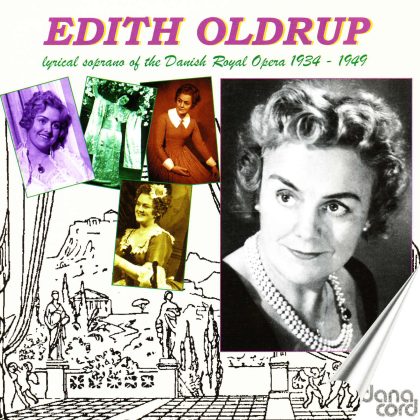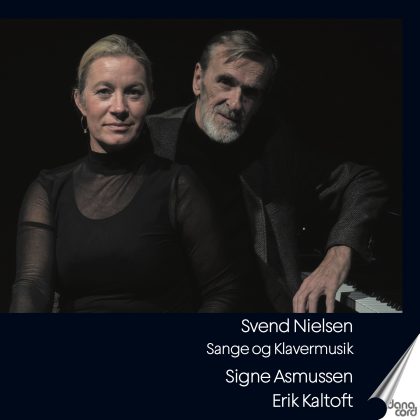Niels W. Gade
From the ballet ”Et Folkesagn”
1. Polonaise
2. Brudevals, Bridal Waltz
H.C. Lumbye
3. Finale-galop “Livjægerne på Amager”
Hans Ernst Krøyer
4. Der er et yndigt Land
Ditlev Ludvig Rogert
5. Kong Christian stod ved højen Mast
Friedrich Kuhlau
From “Elverhøj” (The Elf Hill), Op. 100
6. Akt IV: Ballet – Agnetes drøm
7. Elverdans (Elf’s Dance)
8. Akt V: Kransedans (Garland Dance)
9. Ecossaise
P.E. Lange-Müller
10. Prelude “Der var Engang”
Johann Strauss II
11. Rosen aus dem Süden, Op. 388
Josef Strauss
12. Mein Lebenslauf ist Lieb’ und Lust
Friedrich Kuhlau
13. Potpourri From “Elverhøj”
Friedrich Kuhlau
14. Prelude to the play, “Renaissance”
Niels W. Gade
From ”Et Folkesagn” (A Folk tale)
15. Polonaise
16. Brudevals, (Bridal Waltz)
H.C. Lumbye
17. Drømmebilleder (Dream Pictures)
Carl Nielsen
From ”Maskarade”
18. Overture
19. Hanedans (The Dance of the Cockerels)
20. Music from the play “Moderen” (The Mother)
21. Prelude, 7th Scene
22. March
Jeremiah Clarke
23. Prins Jørgens March (Trumpet Voluntary)
Jacob Gade
24. Tango Tzigane “Jalousie” (1925)
Emmerich Kálmán
25. Komm’ Zigany. From ”Gräfin Maritza”
Emil Reesen ©
by Jens Cornelius
The composer and conductor Emil Reesen (1887-1964) was the remarkable Jack-of-all-trades of Danish music who mastered all genres and styles – the only thing that mattered to him was that the quality of the music was good. His career began in the world of the theatre, where he played the piano in music theatres in Copenhagen and as time went on also began to conduct, arrange and compose music for various operettas and revues. And he was really good at this. During the years around the First World War Reesen came to the conclusion that he was the best conductor in town despite not having studied at the conservatoire. The decisive thing was his considerable innate talent.
Emil Reesen had grown up in a musical family in the heart of Copenhagen and as a child received tuition on various instruments so that he could become a musician just like his father. When he was in his twenties, he had great ambitions and took lessons in harmony and counterpoint with the composer Vilhelm Rosenberg and piano lessons on a virtuoso level with the pianist Siegfried Langgaard, who had studied with Franz Liszt (and who, incidentally, was the father of Rued Langgaard). But he did not think that a career as a purely classical pianist was worth his while. Instead, he came to earn a great deal of money in the theatrical branch, not least as a conductor for the grandiose revues at the Scala in the 1920s, which were comparable with the greatest musical shows in London and Paris. As Scala’s conductor, Reesen was a lionized person, and it was he who composed the revue tunes which became the shows’ great hits.
In 1925 he made up his mind to take the plunge and leave the entertainment business and move to Paris in order to pursue a career in classical conducting there, for among other reasons because he had been invited by the world-famous choreograph Mikhail Fokin. But he did not achieve an international breakthrough, and in 1927 he came back to Copenhagen in order to become the conductor of the Radio Orchestra, the present Danish National Symphony Orchestra. It was an ensemble that grew from a modest piano trio in 1925 to becoming an orchestra of 27 players in 1927 who played several concerts on the radio every day. This task could not be managed by the conductor Launy Grøndahl alone, and from 1927 until 1936 Emil Reesen and Grøndahl shared the post.
The broadcasting corporation stood on the brink of its great golden age, and as a conductor on the radio Reesen reached the largest audience he had ever had yet. He also made a considerable effort to introduce the Danish listeners to newer, international music of composers including Debussy and Gershwin. At the same time, he conducted theatre performances and operettas round about in
Copenhagen in his spare time, and he also continued his enormously busy career as a composer and arranger. It was owing to his incredible musical capacity that it was possible for him to do these things simultaneously. Reesen memorized all the music he heard, and when he made arrangements, he was able to write out the orchestral parts without recourse to a score, because he had it all in his head.
The radio orchestra was highly ambitious and aimed to stand in opposition to music produced by mechanical means. The director of the radio Emil Holm did not therefore approve of his orchestra making records, but after an initial recording made in 1929 it was agreed the following year that Reesen was to conduct a number of popular Danish works on recordings. These were the first records to be made in the history of the Danish National Symphony Orchestra. On these historical recordings Emil Reesen shows himself to be a brilliant conductor who played at rapid tempi with a strongly marked rhythm and irresistible panache. It is easy to imagine that this ability to make the music dance caused the music-hall Scala to simmer with activity in the 1920s.
The classical pieces were supplemented with recordings of the National Anthems which were played each day after the final radio broadcast. In addition, Reesen, probably at his own suggestion, was allowed to record two pieces by the Strauss family. Viennese music was very close to his heart, and as one can hear, he had a firm grasp of the style. What a pity it is that there were no more recordings of Strauss from Reesen’s hand other than these two.
Reesen’s employment at the radio ended suddenly in 1936 when he was dismissed by the management on the grounds of lack of co-operation. Not until the 1940s did he come to conduct his old orchestra once again, and from 1946 there are two wonderful recordings he made with the orchestra and the popular violinist Wandy Tworek. Their version of Jacob Gade’s “Tango Jalousie” is stylistically unsurpassable – Reesen had unfailing musicality. The recording of music from Carl Nielsen’s festival play “Moderen” is also interesting, since this prelude to the 7th scene is one of the movements which Emil Reesen had orchestrated for Carl Nielsen. The collaboration between the two composers was so close that Reesen wrote his orchestrations directly into Carl Nielsen’s handwritten score.
In the 1930s and 1940s Emil Reesen was a regular guest at the recording studios and made about 100 records of music of all kinds. Apart from the pioneer recordings with the Radio Orchestra the most exceptional are a number of records he made In Berlin in September 1940 – in the centre of the stronghold of Nazism, just five months after Germany had occupied Denmark. Reesen was not a Nazi. He was driven by career opportunities and saw the recordings as a rare chance to conduct one of the world’s best orchestras. The plan had come about after the Berlin Philharmonic in 1940 had been on a German charm offensive and given a concert in Copenhagen, and on that occasion it was agreed that the orchestra should make recordings of Danish music for the recording company Nordisk Polyphon conducted by Reesen and the Royal Theatre’s conductor Georg Høeberg. “Germany has wished to have these pieces of music recorded under a Danish conductor so that what is typically Danish is emphasized. And we are of course looking forward to working with the Berlin Philharmonic”, Reesen said to the Danish press who were following the project with considerable interest.
Before judging the collaboration too harshly in the light of history, one must take into consideration that at that time records were very seldom made of Danish orchestral music, and that there certainly had not previously been much interest in recording Danish music abroad. In fact it was almost impossible to hear Danish orchestral works on decent gramophone recordings at that time, so it was of course very exciting that one of the world’s best orchestras would now help improve the situation. It was therefore sufficient reason for Reesen to travel to
Berlin at this stage in the war. Fortunately the result was musically enormously successful. The records were made in the course of a few days at the beginning of September 1940, and in addition to the recordings conducted by Reesen, Høeberg was responsible for the recordings of Kuhlau’s “Elverhøj” overture and extracts from Lange-Müller’s music for the play “Der var engang” (Once upon a time). Already later the same year Emil Reesen manifestly changed his opinion about collaborating with the occupying power. He began to conduct at patriotic rallies of community singing in Copenhagen, and he composed a song of liberty, “Et flag er smukkest i modvind” (A flag is most beautiful in a head wind), which became very widespread. His extremely popular operetta “Farinelli” from 1942 also embodied strong symbolism about resisting oppressors. After the liberation in 1945 Reesen’s German recordings completely disappeared from public view in Denmark. They were neither re-issued nor played on the radio. They were not mentioned at all, and the collaboration did not come to affect Reesen’s popularity. The records and the history surrounding them were confined to oblivion. Thanks to the recording engineer Claus Byrith we can today re-experience this special, but not atypical collaboration dating from the first years of the war, when many people were in doubt as to whom one could trust and what the world of the future held in store.
Emil Reesen also worked closely with the Royal Danish Orchestra for many years. He conducted the orchestra for the first time in 1931 when he presented his sensational ballet “Gaucho” in Latin American style at the Royal Theatre. In the beginning of the 1930s followed his ballets “Gudindernes strid” and “Zaporogerne”, and after Reesen in 1950 again became the regular conductor of the theatre, he composed and performed a large number of productions with music. The Royal Danish Orchestra often made recordings in the 1930s. The pot-pourri from “Elverhøj” was recorded in 1935 – it was music that Reesen had known all his life from his teens when he worked as a theatre pianist, and until his work in the 1950s at the Royal Theatre. Reesen and the Royal Danish Orchestra made yet another historical recording just after the liberation in 1945: “Prins Jørgens March” (Trumpet Voluntary), which during the occupation had been the signature tune for the BBC broadcasts to an occupied Denmark. Now this music could finally be played and enjoyed in a liberated Denmark.
Reesen made his last record in 1953. The year after he became seriously ill and had to live in seclusion for the last ten years of his life. But many of his compositions are still popular today, and thanks to this re-issue we can now also hear how his personality and overwhelming musicality made him not only one of the biggest names in Danish musical life, but simply one of the most famous Danes of his time.
RELEASE DATE: January 2023
CATALOGUE NUMBER.: DACOCD 958
EAN: 5709499958001




